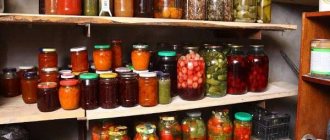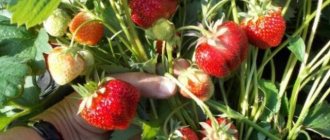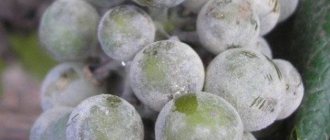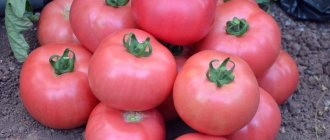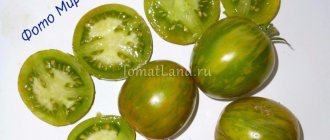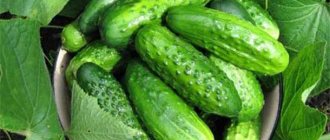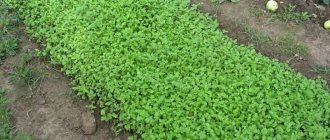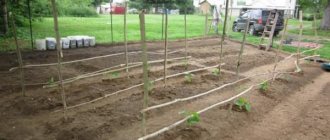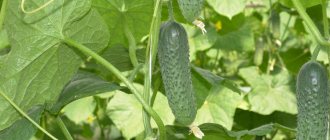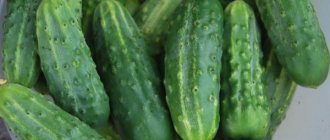History of variety development
Crispina F1 cucumber was bred by Dutch breeders from the breeding and seed company Nunhems BV in the last quarter of the last century. In the last years of the last century, seeds of this variety were actively purchased by vegetable growers from around the world, including from Russia.
Important!
What does the f1 hybrid mean?
As a result, the Crispina F1 cucumber passed variety tests at Russian test sites and was included in the State Register of the country in 2000.
Related article:
How to make cucumbers bear fruit before the first frost?
This cucumber hybrid is recommended for growing in garden plots, household plots and small farm plots in almost all Russian regions. It is intended for planting in garden beds, greenhouses and film greenhouses.
Ofazende.ru recommends: Cucumber Karin F1 – description and characteristics of the variety
Hybrid cucumber Crispin F1
Crispina is an F1 hybrid cucumber bred by Dutch breeders. Since 2000, it has been listed in the State Register of the Russian Federation as a variety for dachas, small farms and household plots. Allowed for cultivation in most regions of the country. Crispina cucumber can be cultivated in ordinary beds, as well as in closed ground.
The variety is parthenocarpic, so additional pollination of the inflorescences is not required.
Resistance to unfavorable conditions allows even beginners to grow “Crispina” on their plots. It is allowed to grow without vertical tying of the vines, but if you use tying, the yield will be higher. If we compare “Crispina” with other hybrid varieties, we can say that the variety is less dependent on comfortable temperatures in the first half of the growing season and tolerates hot weather more persistently. Productivity - 6.3 kilograms per square meter. The fruits are formed of the same size (length 10-12 cm, diameter 4 cm). the weight of greens of the “Crispina” variety reaches 100-120 grams. The fruits are cylindrical with a slight influx at the top. The color is uneven from green to dark green, with small round whitish spots and light stripes. The surface of the greens is pubescent with white spines.
Cucumbers have dense, crispy and aromatic flesh; there is no bitterness. The “Crispina” variety is suitable for universal use, both fresh and as part of winter preparations. Cucumbers tolerate transportation well, so they are often grown for sale.
The plant is medium-sized with medium-branched vines, the root system is well developed. It is the powerful root system that allows the plant to receive nutrition when there is not enough moisture coming from outside. The leaves are not too large, slightly wrinkled. The more heat and light, the darker the leaf. From one to three ovaries are formed in the leaf axil.
When growing “Crispina” in a greenhouse, the formation of the bush is carried out in one stem with lateral stepsons. To obtain an early and high harvest, the first 4-5 axils are “blinded” completely, that is, all stepsons, leaves and ovaries are removed. The next 3-4 nodes are removed from the stepsons, and one ovary is left in the leaf axils. In the next 4-5 nodes of the ovary, everything is left, and the stepsons are pinched after the first leaf. Further along the lash, pinching of the stepsons is carried out after the third leaf. When the lash reaches the top point, it is wrapped around a horizontal trellis and the stem is directed downward. You need to completely pinch the stem at a distance of a meter and a half from the ground. As the plant grows and ages, the lower leaves are removed.
Cucumber "Crispina" is resistant to a number of diseases inherent in the pumpkin family. It is practically not susceptible to cladosporiosis, powdery mildew and common mosaic.
Description
This hybrid cucumber belongs to the parthenocarpic type - this means that the ovaries on its vines are formed without pollination by insects. As a result, the seeds of ripe greens do not develop, but remain at the stage of milky maturity and are not suitable for planting.
Crispina cucumber F1 seeds
But due to the fact that the Crispin F1 cucumber does not require pollination, it can be safely grown indoors (greenhouses or film greenhouses), where it is difficult to ensure the appearance of bees, but the yield of parthenocarpics will not suffer from this.
Related article:
Cucumber Pasalimo F1 – variety characteristics, description and reviews
In terms of ripening time, the Crispina F1 cucumber belongs to the mid-season hybrids - from the moment the sprouts appear until the first harvest of gherkins is harvested, it usually takes about 1.5 months. Fruiting is extended over time, and the greens ripen on the vines almost until frost. The bushes of this variety are medium in size, up to 1.7-1.8 m high, the root system is large. The shoots are quite powerful, medium-leafy. The foliage is not large in size, with several lobes, slightly wrinkled, dark emerald in color.
It should be noted that a large number of stepsons are formed in the sinuses, from which lateral lashes are actively formed. Fruiting occurs on them after it ends on the central shoot.
The lashes of this cucumber can be grown vertically on trellises or a special cucumber net, as well as on the soil.
The flowers are small in size, collected in bunches of 4-5 pieces. Mostly only female type flowers are formed on the vines.
Related article:
Cucumber Serpentine - description and characteristics of an early ripening variety
Crispin's cucumber F1
Ripe greens are medium in size, cylindrical in shape, usually ripen equal in length and volume. The maximum length of cucumbers is 10-12 cm, diameter is up to 5 cm, average weight is 90-100 g.
The skin is not dense, crispy, covered with large tubercles in large quantities and dark short spines. Pubescence is slight and light. The color of the skin is dark emerald, with short longitudinal light stripes clearly visible on it.
The pulp is tender, with a characteristic crunch, without voids or bitterness. Seeds inside the pulp - in small quantities at the stage of milk maturity. The harvested crop easily tolerates transportation over different distances and has a long shelf life.
Further care of plants
Cultivating the Crispin hybrid after planting is not difficult: only normal agricultural work should be performed.
Watering
Any culture cannot do without moisture. Watering is especially important for cucumbers, since they are moisture-loving plants .
Water the cucumber bushes daily only with warm water - otherwise the plants may be affected by rot. Of course, during the rainy season the frequency of moisturizing should be reduced.
To help moisture stay longer in the soil, the area around the seedlings is mulched. For this purpose, it is good to use inorganic materials (peat, wood shavings, etc.).
Such mulch not only retains moisture, but also, when rotting, releases heat and replenishes the soil with useful elements.
When watering, it should be taken into account that excessive moisture causes compaction of the soil, due to which the root system of cucumbers lacks air. To give access to oxygen, it is recommended to combine watering with loosening the soil.
Important! It is better to loosen the ground under cucumber bushes with a pitchfork - they pierce the ground and allow air to flow to the roots without injuring them.
Stepsoning
When growing cucumbers in protected conditions, the bush will have to be formed into a main single shoot with lateral shoots. But if you wish, you can grow the crop in the spread.
When the plant has 6–7 nodes, on the first 5 buds it is necessary to completely remove the shoots and fruit embryos, leaving only 1 stem. At the next 3-4 nodes, the stepchildren need to be pinched, but at the same time keep a single ovary on each.
After this procedure, all the ovules should be left and the stepsons above the first leaf should be cut off, then the shoots above the second or third leaf should be shortened (depending on the density of the bush).
After the guiding stem of the bush reaches the top of the lattice, it is directed parallel to the row at a distance of 0.7–1.0 cm and directed downwards. The main stem is pinched at a height of 0.9–1.0 cm from the ground.
As the bushes grow and age, it is better to remove the lower foliage - this improves air exchange and prevents cucumbers from becoming sick.
Garter bushes
When grown outdoors, the Crispin hybrid does not require a garter - the bushes are able to independently organize the space so as not to disturb their neighbors. But in a greenhouse environment, gartering of lashes is mandatory.
Fertilizer application
The Crispin hybrid develops a strong rhizome and a powerful aerial segment. Therefore, his nutrition must be maintained at the proper level. The crop responds especially well to potassium-containing fertilizers.
They can be applied either topically (directly to the ground) or through an irrigation system.
Did you know? People love cucumbers so much that they even erect monuments to them.
For example, such monuments were installed in Nezhin (Ukraine), Lukovitsy, Stary Oskol (Russia), Poznan (Poland), Shklov (Belarus).
After the harvest has been harvested several times, the bushes should be fed with nitrogen-potassium mixtures. Organic compounds (manure, chicken droppings, etc.) or mineral fertilizers (calcium nitrate, potassium sulfate or potassium nitrate) are perfect for this.
Fertilize cucumbers once every 10–14 days, performing the procedure at the root.
Soil care
The soil on which cucumbers grow should not be ignored. Once the soil has crusted over, it needs to be loosened. Perform work using a rake or shovel.
You can’t push the tool too deep into the ground, as this can damage the root system.
To avoid the occurrence of diseases, the soil around the bushes is regularly cleared of weeds. Timely removal of weeds will help the roots receive adequate nutrition.
It is also important that there are no foreign objects in the soil - they can inhibit the development of roots and the bush as a whole. In places where the root system has begun to show out, it is worth hilling up, covering such places with a thick layer of soil.
Did you know? The first greenhouses for growing vegetables were built in Ancient Rome. This happened at the behest of Emperor Tiberius, who wanted to enjoy cucumbers all year round.
Main characteristics of the variety
This hybrid is resistant to sudden changes in weather conditions, is resistant to low air temperatures at the stage of seedling development, and can easily tolerate heat during the fruiting period, without reducing the yield and the speed of formation of ovaries.
Related article:
When and what to feed cucumbers for the first time for a bountiful harvest
Productivity
The yield of Crispin F1 cucumber is quite high - from each square of area you can collect up to 10-12 kg of ripe gherkins, depending on the place of cultivation. Usually in greenhouses the yield of this cucumber is higher than when grown in garden beds.
Area of application of fruits
Ripe cucumbers have a pleasant taste, so they are added to summer salads and other snacks. Crispin F1 hybrid cucumbers are also suitable for winter canning and pickling, as well as for preparing winter salads.
Harvest and storage
By the end of the second month after planting the grains, the first young cucumbers appear. At first they form in small quantities, but after a couple of weeks the yield reaches its peak. There is no need to keep the fruits on the vines: the abundant amount and weight damage the plants and the fruits become overripe. Harvesting is carried out regularly, every 2-3 days. The more often you remove already ripe fruits, the more strength the plant will have to develop new ones.
After harvesting, cucumbers are soaked in cold water, washed, and then used for their intended purpose. If you don’t plan to eat or process them in the near future, you can store the greens in a cool place, but you don’t need to wash them with dirt first. Moisture on the skin causes the fruits to become soft and lose their juiciness, and may even rot. It is enough to wipe the greens with a dry towel, put them in a box covered with newspaper or papers and put them in the basement; you can put the box in the refrigerator. The maximum shelf life under cool conditions should not exceed 2 weeks.
Diseases and pests
Like other Dutch cucumber hybrids, Crispina F1 is highly resistant to diseases that affect other varieties and hybrids of cucumbers, in particular powdery mildew, common mosaic and cladosporiosis.
Related article:
How to prolong the fruiting of cucumbers?
Among the pests, aphids or some pests may appear on the cucumber vines of this hybrid. To scare them away, you can plant plants and flowers with a strong smell in the spaces between the rows - onions, garlic, marigolds or marigolds.
Agricultural technology or proper cultivation
The hybrid can be grown in two ways:
- Direct planting of seeds;
- Seedling method.
Experienced vegetable growers recommend using the seedling method, since in this case you can get an earlier harvest, use fewer seeds and protect the plants at the initial stage of development.
To plant seeds, you should use nutritious soil consisting of one part humus, three parts peat and one part turf soil.
IMPORTANT: Potassium sulfate, ammonium nitrate and superphosphate must be added to the soil.
When preparing the soil, it is very important to monitor the acidity level. It should not exceed 6.2-6.5 pH.
Seeds are planted in pots with a diameter of at least 8-9 cm. The planting depth should be about 2 cm, and the soil temperature should be 15-20 degrees Celsius.
Seedlings are planted in unprotected soil or a greenhouse after the appearance of 3-4 true leaves to a depth of 2-3 cm. The soil should be light and nutritious. Superphosphate, coconut fiber, nitrogen and potassium fertilizers, and humus are added to the soil. Experts in the field of growing cucumbers recommend adding vermiculite to the soil - this mineral will help regulate moisture levels.
After planting the seedlings, the soil is immediately watered with warm and settled water.
The main advantages of the variety
The main advantages of the cucumber hybrid Crispin F1 include:
- long-term abundant fruiting;
- undemanding to growing conditions and care;
- resistance to sudden changes in temperature;
- cucumber hybrid Crispin F1 has high immunity to the main diseases characteristic of cucumber crops;
- the harvested crop is of universal use;
- ripe greens can be transported to any distance and stored for a long time;
- good appearance of the collected gherkins.
disadvantages , but many vegetable growers attribute the disadvantages of this cucumber to the fact that seeds for planting have to be constantly purchased in specialized stores.
Related article:
Terms and rules for planting cucumbers for seedlings in 2021
Reviews from gardeners who have previously grown
Marina
Last year, a neighbor at her dacha grew Crispina, so I decided to try it. I purchased Dutch seeds and first sowed them for seedlings on April 20, because I was afraid that the plants would freeze in the open ground. Already a week after sowing, shoots began to appear, and after another 3 weeks I transplanted the seedlings. The cucumbers grew like gherkins: small, aromatic and tasty, with crispy flesh. Everything I like. There is no bitterness in the taste, so I recommend it for those who like to eat vegetables straight from the garden.
Nina
I have been planting the Crispin cucumber hybrid for 5 years in a row and have not noticed any shortcomings yet. I can’t be at the dacha all the time, so sometimes I leave the plantings without watering, and the plants tolerate it fine. During all the time of breeding, I have never had to deal with infection, and I do not treat the bushes specially. The yield is 8-9 kg per m2, this amount is enough for me both for pickling and for fresh consumption.
Nuances of planting and care
This cucumber hybrid can be grown in the garden or in greenhouse conditions using seedlings or without seedlings.
Seed material is planted directly into the ground mainly in the southern regions. In this case, the soil should warm up to +14+15 degrees Celsius, and the average daily air temperature should always be the same.
Seeds for seedlings are planted immediately in separate pots (preferably in peat cups), since cucumbers have a very delicate root system that does not tolerate frequent transplanting and picking.
After 2-3 true leaves appear on the seedlings, they should be fed with organic fertilizer - diluted mullein or bird droppings.
About a month after germination of the seed material, the plants are ready for transplanting. By this time, 5-7 true leaves appear on the seedlings.
Cucumber seedlings can be transplanted into unheated greenhouses or film greenhouses at the end of the first ten days of May. The deadline for transplanting seedlings into garden beds is the last ten days of May. In this case, the soil in the beds should warm up to +15+14 degrees Celsius.
Related article:
Cucumber Satina F1 – characteristics of an early ripening variety, reviews
It is necessary to correctly calculate the timing of planting seeds for seedlings, so that by the time the plants are transplanted to the prepared site, the weather is suitable. If the seedlings stay at home longer than expected, they begin to outgrow and become very elongated. Such plants will not take root well in a new place, and their productivity will not be high.
When transplanting seedlings to a permanent place, you need to maintain a distance between planting holes of 0.3-0.4 m, and a distance between rows of 0.8-0.9 m.
When growing this cucumber hybrid, its vines need to be tied to trellises - this will make it easier to care for these vegetable plants and easier to harvest.
Usually, seedlings of this cucumber are transplanted into prepared holes by transferring them together with a lump of earth, in this case the roots of the cucumber will not be damaged, and the plant itself will quickly acclimatize in the new place.
Related article:
6 rules for caring for cucumbers in August that will ensure a good harvest
Landing Features
Crispin f1 cucumbers are grown not only in open ground: cucumbers are also grown in greenhouses and greenhouses. Cucumbers are sown, and pre-prepared seedlings are also planted.
As a rule, planting Crispin cucumbers is carried out in several stages: initially, good seeds are planted, not too small and not damaged.
Landing dates
The planting time for the Crispina variety depends on the planting method: seeds or seedlings. If cucumbers are planted by seedlings, the plant is transplanted at the end of May. If cucumbers are sown, mid-May is suitable for planting.
However, do not forget about the soil temperature. Experienced gardeners recommend planting the Crispin cucumber variety only after the ground has warmed up to 10-15 degrees Celsius.
Site preparation
For planting Crispin cucumbers, soil containing a small amount of alkali is suitable. Before planting cucumbers, the soil is saturated with minerals: coconut fiber, humus, vermiculite or fertilizers that contain potassium or nitrogen.
In addition, Crispin's cucumbers love light, therefore, it is necessary to choose a well-lit area protected from the wind. Cucumber seed should not be planted in a place where the groundwater level is high.
Crispin's cucumbers should not be planted on land where beets or zucchini were previously grown. It is recommended to plant the variety after cabbage, green manure, legumes, or after corn.
Planting seeds
Before planting the seeds of the Crispina variety, they are placed in a damp cloth and sent to a cold place for 24 hours. A day later, the planting material is treated with manganese and sown in the ground.
Planting seedlings
For the seedling method of growing cucumbers, the plant seeds are placed in small peat pots. The seed is placed in the ground at a depth of 2 cm. After the first shoots appear (approximately 30 days after sowing), the seedlings can be transplanted into open soil.
It should be noted that seedlings of the Crispina variety are planted before they reach large sizes: the seed should not be allowed to outgrow and stretch. Otherwise, the cucumbers will not bear fruit.
Planting scheme
Crispin f1 cucumbers are planted using the trellis method. As a rule, 80 cm are left between the trellises. In addition, it is not recommended to make trellises that are too high: their height should not exceed 1 m.
Leave up to 40 cm between seedlings. When planting cucumbers in open ground, it is necessary to raise the land area by 15 cm. It is recommended to plant seeding material up to 3 cm deep.
After planting Crispin cucumbers, the soil is moistened. It is recommended to plant cucumbers in the morning or evening.
It should be noted that you should not plant cucumbers next to tomatoes, since both crops have a reduced yield level.
How to care for cucumbers of this hybrid
Crispin's F1 cucumber does not require special care, so even novice vegetable growers can grow it. The set of measures for caring for the bushes of this cucumber is as follows:
- irrigation with warm, settled water in the evening;
- loosen the root zone after watering;
- regular weeding and removal of weeds along with the roots;
- regularly remove excess stepsons;
- treat cucumber vines with appropriate preparations against harmful insects;
- regular application of fertilizers;
- spraying the root zone of cucumbers with appropriate fungicides against root and stem rot of the cucumber crop.
Reviews from summer residents about the hybrid
Numerous positive reviews indicate the high popularity of the Crispin hybrid (F1). The cucumber variety is so easy to grow that even a beginner can cope with this task.
The hybrid is resistant to many diseases, and this feature makes it possible to minimize the treatment of plantings with chemicals. According to many vegetable growers, the yield of cucumbers increases significantly when the fruits are harvested in a timely manner. To prevent greens from overgrowing, they should be picked every day.
Gardener's review of the variety:
- Kriss, 29 planning: I met Crispina quite a long time ago. About 10 years ago. My beloved impressed me right away. Firstly, for its excellent productivity and relative ease of care. Summe was treated with fertilizers and chemicals a couple of times a season. Cucumbers grow tirelessly; you need to pick them regularly. Moreover, Crispina bears fruit for quite a long time. Secondly, and this was even more important for me, great love for cucumbers. Having picked one from a bush and tried it, it is simply impossible to tear yourself away later. I will continue to grow Crispina!
- Victoria, 43 years old: Brilliant, productive, delicious variety! Or rather, not a variety, but a hybrid. But this is not so important. What’s more important is that Crispina has been delighting me and my family with her wonderful cucumbers for several years now. It is also allowed to roll, ferment, and of course just eat fresh. And treat the neighbors again and again. I really love this Crispina.
Pros and cons of the variety
Christina f1 is an easy to grow cucumber, moderately resistant and quite fertile. It can be cultivated on large farms and small dachas for family use. This is a good choice for those who are just starting their vegetable gardening journey.
pros
The variety has several noticeable advantages compared to other similar hybrids. It is productive, undemanding and resistant to viruses. The most important advantages of Christina f1:
- cold resistance - plantings can tolerate light night frosts;
- fertility - with proper care, the variety allows you to get a harvest of more than 15 kg/m²;
- excellent immunity - green grass, judging by the description, is resistant to powdery mildew and cladosporiosis, and is rarely affected by mosaic;
- good taste - the cucumber is not bitter, has a pronounced aroma and crunch.
The vegetable can boast of excellent marketability: its fruits are neat, even, rich in color, shiny and beautiful.
Minuses
The variety does not have many negative qualities, and they are typical for such hybrids. The most significant disadvantages of Christina f1:
- parthenocarpicity - it will not be possible to collect seeds from the harvest; you will have to buy them every season;
- indeterminism and branching - the cucumber has tall, rapidly growing bushes and will require careful work on its formation;
- inability to prepare pickles - the gherkins from Christina turn out excellent, but a very small cucumber has not yet acquired enough flavor to be preserved;
- increased need for moisture and the tendency of the variety to overgrow.
